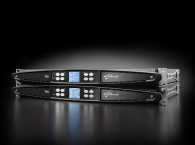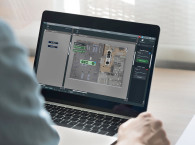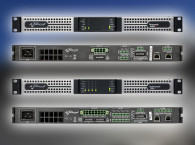
At its headquarters in Ilmenau, Germany, and its branch lab in Oldenburg, the institute employs over one-hundred people to work on its diverse research portfolio. Together with its contracting partners, the institute develops cutting-edge solutions consistently designed to meet the industry’s most exacting requirements and expectations.
In order to maintain the highest possible standards during this specialized work, Fraunhofer IDMT has made the decision to invest in a brand new range of Powersoft Ottocanali 4k4 DSP+D amplifier platforms, further strengthening its long-standing relationship with the manufacturer.
“We have a long story with Powersoft and have developed a good understanding of their systems over the years. Back when we installed our first Powersoft amplifiers here, we had direct contact to the guys in Italy as well as their German distributor, Laauser & Vohl GmbH. Normally we know very well what gear we want and in this most recent case the choice was easy. We ordered the amps without delay and received great support throughout,” commented René Rodigast, business manager in the acoustics department at Fraunhofer IDMT.


A total of 29 Ottocanali 4k4 DSP+D amplifier platforms were required to meet the institute’s aspirations, with 16 of those units being installed in the building’s 3D Presentation Room alone.
“This room is one of our biggest experimental rooms,” adds Rodigast. “The goal when we created it was to have an efficient and flexible setup. The room is equipped with 117 loudspeakers and is able to accommodate a small number of subwoofers as well. All of the speakers can switch to different setups. One of our standard configurations is a stage setup of below-stage subs and some front fill, and a system enclosing the ‘audience’. Thanks to the certified acoustics, we can simulate other systems as well, such as stage, cinema, planetarium, and even home setups.”
The model chosen to drive this complex setup, the Ottocanali 4k4, is a flexible and reliable 8-channel power amplifier with up to a total of 4,000 W at 4Ω, ideal for multi-zone applications such as the Fraunhofer IDMT’s 3D presentation room. The unit features switchable main/aux signal inputs and offers a wide range of system control, alarms, GPI/O and monitoring functions as well as sound shaping options.
“The amplifiers' Dante capabilities make the system very flexible, which is ideal when using different speaker setups in the room. It is also easy to use the Dante metrics - we often have projects with students who are not used to the system but it’s easy to explain to them how it works. Flexibility is so important as we have different hardware and software all the time. It’s good for us to have a reliable audio network where we can work quickly and easily switch channels,” Rodigast continued.

The systems at the institute are sometimes required to run 24/7, which meant that reliability was another key factor in their decision. To that end, the Ottocanali 4K4 implements redundant universal switch mode power supplies with PFC and patented SRM (Smart Rails Management) technology maximizing reliability, efficiency and reducing power consumption. This in turn saves valuable energy; keeping both the operational cost and carbon footprint of Fraunhofer IDMT’s work at a minimum.
Rodigast went on to explain the wider layout of the institute itself: “In our acoustics department we have a lot of research and sound possibilities. Our biggest room, the 3D Presentation Room, is where we conduct R&D in relation to 3D sound systems. We also have a 3D sound studio, which is used for creating the 3D sound content and for presentation of technology.”
The studio itself houses more Powersoft amplifier platforms, as well as computers, digital / analogue converters and the playback system. “We go directly from the PC to the amps via Dante and from there we go direct to the loudspeakers in the 3D room,” he explains.

Aside from these rooms, there is also a full anechoic chamber at Fraunhofer IDMT’s HQ, which is one of the biggest in Germany at 10m x 9m x 8m. The room is capable of accommodating measurements down to 60Hz and allows the team to conduct very precise work in low frequencies, which is very important for the improvement of sound reinforcement systems.
“We also have a garage that contains a car equipped with a wave field synthesis sound system, and a room where we can do listening tests. All of these have certified room acoustics, which means they are independent of acoustical conditions,” Rodigast adds.
One of the principles explored in depth at Fraunhofer IDMT is Wave Field Synthesis (WFS). Through conducting numerous experiments, the institute came up with Spatial Sound Wave (SSW) technology - an object-based system for producing 3D sound.
“Using SSW, audio objects can be positioned at will, providing a totally realistic compliance of what is seen and heard,” Rodigast explains. “We have a real-time rendering system wherein we create signals for the loudspeakers, which then come straight from the mixing desk. It integrates with our SSW interface very effectively.”

SSW technology can be used for a variety of applications. Recently an SSW 3D sound system was installed on TUI Cruises vessel, Mein Schiff 1, and in its multi-functional entertainment room. Rodigast added: “We can provide the same service for other applications as well. The main strengths of SSW are that it allows you to solve acoustical problems while also providing exceptional audio quality. We don’t talk about the ‘sweet spot’ any more, as we can create an entire 'sweet area'.”
Using SSW, audio content can be produced for reproduction by any audio system and loudspeaker setup. Reprocessing and adaptation of scenes or effects is not required. “We can accommodate most applications on the pro audio market here at Fraunhofer IDMT. We are currently doing things in the video side of the market as well, combining 3D sound with VR and headphone applications. We also have aspirations of working outside pro audio in areas such as industry and maybe medical technology,” Rodigast concludes.
www.idmt.fraunhofer.de | www.powersoft.com






